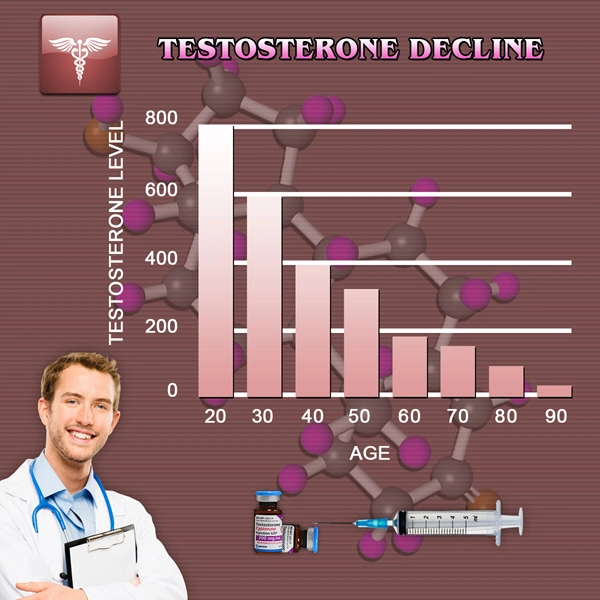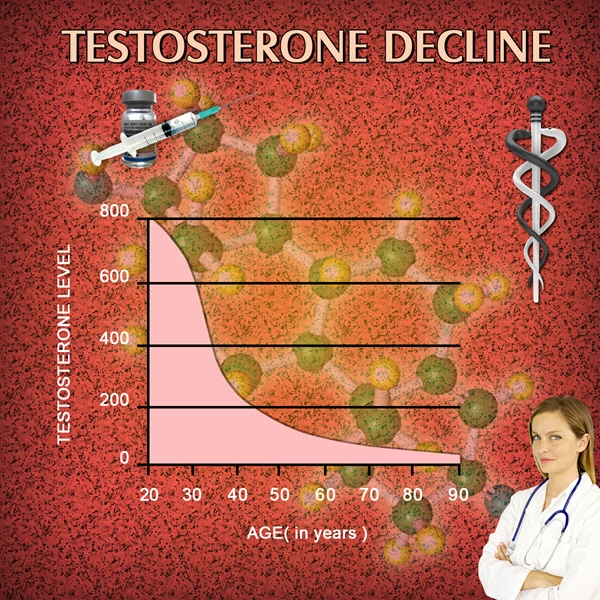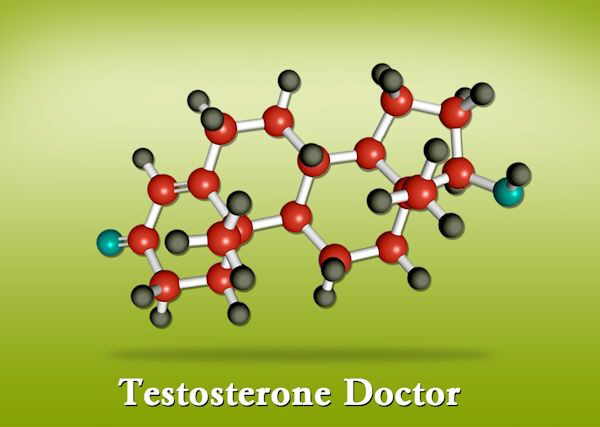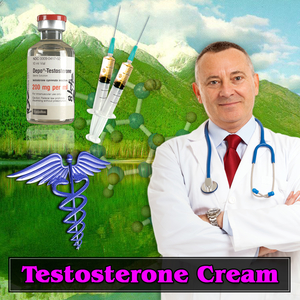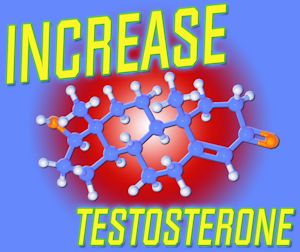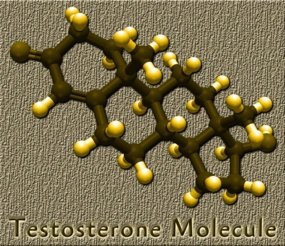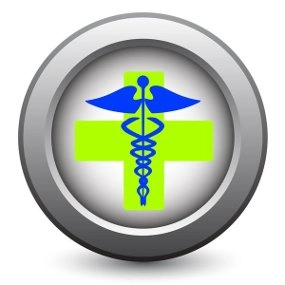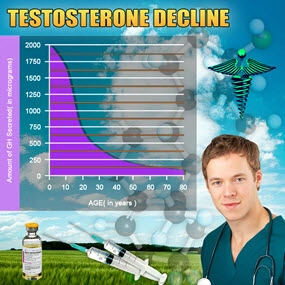Endogenous androgens are responsible for normal growth and development of the male sex organs and for maintenance of secondary sex characteristics. These effects include growth and maturation of the prostate, seminal vesicles, penis, and scrotum; development of male hair distribution, such as beard, pubic, chest, and axillary hair; laryngeal enlargement, vocal cord thickening, and alterations in body musculature and fat distribution. Drugs in this class also cause retention of nitrogen, sodium, potassium, and phosphorous, and decreased urinary excretion of calcium. Androgens have been reported to increase protein anabolism and decrease protein catabolism. Nitrogen balance is improved only when there is sufficient intake of calories and protein.
Androgens are responsible for the growth spurt of adolescence and for eventual termination of linear growth, brought about by fusion of the epiphyseal growth centers. In children, exogenous androgens accelerate linear growth rates, but may cause disproportionate advancement in bone maturation. Use over long periods may result in fusion of the epiphyseal growth centers and termination of the growth process. Androgens have been reported to stimulate production of red blood cells by enhancing production of erythropoietic stimulation factor.
During exogenous administration of androgens, endogenous testosterone release is inhibited through feedback inhibition of pituitary luteinizing hormone (LH). At large doses of exogenous androgens, spermatogenesis may also be suppressed through feedback inhibition of pituitary follicle stimulating hormone (FSH).
There is a lack of substantial evidence that androgens are effective in fractures, surgery, convalescence, and functional uterine bleeding.
Testosterone esters are less polar than free testosterone. Testosterone esters in oil injected intramuscularly are absorbed slowly from the lipid phase; thus, testosterone cypionate can be given at intervals of two to four weeks.
Testosterone in plasma is 98 percent bound to a specific testosterone-estradiol binding globulin, and about 2 percent is free. Generally, the amount of this sex-hormone binding globulin in the plasma will determine the distribution of testosterone between free and bound forms, and the free testosterone concentration will determine its half-life.
About 90 percent of a dose of testosterone is excreted in the urine as glucuronic and sulfuric acid conjugates of testosterone and its metabolites; about 6 percent of a dose is excreted in the feces, mostly in the conjugated form. Inactivation of testosterone occurs primarily in the liver. Testosterone is metabolized to various 17-keto steroids through two different pathways.
The half-life of testosterone cypionate when injected intramuscularly is approximately eight days.
In many tissues the activity of testosterone appears to depend on reduction to dihydrotestosterone, which binds to cytosol receptor proteins. The steroid-receptor complex is transported to the nucleus where it initiates transcription events and cellular changes related to androgen action.
Originally posted here:
DailyMed - TESTOSTERONE CYPIONATE- testosterone cypionate ...
Contact Us Today For A Free Consultation

- Tesosterone - Injectible or Gel? [Last Updated On: November 20th, 2023] [Originally Added On: August 10th, 2011]
- Welcome to autumnhorne Testosterone Cypionate A Potent Long ... [Last Updated On: June 14th, 2025] [Originally Added On: February 19th, 2013]
- Compared – Essential Details In testosterone cypionate | Health ... [Last Updated On: August 21st, 2025] [Originally Added On: May 17th, 2013]
- Testosterone Cypionate And Its Use In Sports » I Click U Click ... [Last Updated On: January 4th, 2018] [Originally Added On: July 23rd, 2013]
- Testosterone Cypionate Advantages And Disadvantages » I Click U ... [Last Updated On: January 18th, 2018] [Originally Added On: July 25th, 2013]
- will testosterone cypionate build muscle | Pro Testosterone [Last Updated On: August 29th, 2025] [Originally Added On: July 30th, 2013]
- Subcutaneous Testosterone Cypionate Injection - Video [Last Updated On: August 22nd, 2013] [Originally Added On: August 22nd, 2013]
- Testosterone Cypionate and Testosterone Enanthate Information [Last Updated On: September 11th, 2025] [Originally Added On: October 31st, 2013]
- Testosterone Cypionate - Testosterone Cypionate .com [Last Updated On: March 26th, 2025] [Originally Added On: October 31st, 2013]
- Testosterone Cypionate - Testosterone Injections | Testosterone ... [Last Updated On: January 21st, 2018] [Originally Added On: October 31st, 2013]
- testosterone cypionate IM : Uses, Side Effects, Interactions ... [Last Updated On: January 5th, 2018] [Originally Added On: November 3rd, 2013]
- Testosterone Cypionate Official FDA information, side effects and ... [Last Updated On: January 13th, 2018] [Originally Added On: November 6th, 2013]
- Testosterone Cypionate - Steroid .com - Anabolic Steroids ... [Last Updated On: January 6th, 2018] [Originally Added On: November 6th, 2013]
- Testosterone Cypionate - Steroidology.com | Uncover the truth ... [Last Updated On: November 25th, 2018] [Originally Added On: November 10th, 2013]
- Testosterone cypionate: Indications, Side Effects, Warnings ... [Last Updated On: January 20th, 2018] [Originally Added On: November 10th, 2013]
- Testosterone Cypionate - Testosterone Injections ... [Last Updated On: January 26th, 2018] [Originally Added On: November 16th, 2013]
- Testosterone Cypionate Official FDA information, side effects ... [Last Updated On: January 23rd, 2018] [Originally Added On: November 17th, 2013]
- Testosterone Cypionate – A Gentle Way to Elevate ... [Last Updated On: March 28th, 2025] [Originally Added On: November 23rd, 2013]
- Testosterone Cypionate Injection, USP100 mg/mL and 200 mg/mL [Last Updated On: December 23rd, 2017] [Originally Added On: December 6th, 2013]
- Testosterone Cypionate - Steroid .com [Last Updated On: December 16th, 2017] [Originally Added On: December 21st, 2013]
- Testosterone Cypionate for Muscle Building | eHow [Last Updated On: January 12th, 2018] [Originally Added On: December 30th, 2013]
- Testosterone cypionate: Indications, Side Effects ... [Last Updated On: January 20th, 2018] [Originally Added On: January 20th, 2014]
- Testosterone Cypionate - Steroidology.com | Uncover the ... [Last Updated On: November 25th, 2018] [Originally Added On: January 27th, 2014]
- Testosterone Cypionate - Steroids Profile [Last Updated On: October 25th, 2020] [Originally Added On: March 11th, 2014]
- Buy Testosterone Cypionate Injection Online | steroid ... [Last Updated On: October 29th, 2018] [Originally Added On: April 15th, 2014]
- Testosterone Cypionate - Roid-Shop.com [Last Updated On: October 3rd, 2020] [Originally Added On: April 30th, 2014]
- Testosterone Cypionate - FDA prescribing information, side ... [Last Updated On: October 21st, 2020] [Originally Added On: May 2nd, 2014]
- TestosteroneCypionat - TOMA Ardream warrior - priest ANATOLIA - GiYOTiN Clan - Video [Last Updated On: October 8th, 2020] [Originally Added On: May 6th, 2014]
- Testosterone Cypionate A Gentle Way to Elevate ... [Last Updated On: October 6th, 2020] [Originally Added On: May 8th, 2014]
- Derivatives Of Testosterone - Testosterone Cypionate dosage and side effects - Video [Last Updated On: August 30th, 2014] [Originally Added On: August 30th, 2014]
- Derivatives Of Testosterone - What does Testosterone Cypionate do - Video [Last Updated On: November 23rd, 2020] [Originally Added On: August 30th, 2014]
- testosterone cypionate intramuscular : Uses, Side Effects ... [Last Updated On: January 5th, 2018] [Originally Added On: September 1st, 2014]
- Anabolic Steroids List: Benefits of Testosterone Cypionate [Last Updated On: May 4th, 2015] [Originally Added On: September 17th, 2014]
- Genuine Cheap Testosterone Cypionate for Sale Online [Last Updated On: June 19th, 2015] [Originally Added On: January 20th, 2015]
- Testosterone Cypionate A Potent Long-Acting Androgenic Anabolic ... [Last Updated On: June 19th, 2015] [Originally Added On: February 18th, 2015]
- Welcome to Testosterone Cypionate A Potent Androgen [Last Updated On: June 19th, 2015] [Originally Added On: February 18th, 2015]
- Testosterone Cypionate - Growth hormone [Last Updated On: October 4th, 2020] [Originally Added On: March 5th, 2015]
- Depot Testosterone (Testosterone Cypionate) [Last Updated On: October 6th, 2020] [Originally Added On: March 6th, 2015]
- TESTOSTERONE CYPIONATE | XRoids.com [Last Updated On: October 22nd, 2020] [Originally Added On: March 17th, 2015]
- Testosterone Cypionate Injections for Sale - Best Price on ... [Last Updated On: November 16th, 2020] [Originally Added On: April 4th, 2015]
- Buy TESTOSTERONE STEROIDS: Testosterone Cypionate [Last Updated On: October 11th, 2020] [Originally Added On: May 23rd, 2015]
- Testosterone Cypionate for Sale: Injectable Testosterone ... [Last Updated On: November 17th, 2020] [Originally Added On: May 26th, 2015]
- Depo-Testosterone (Testosterone Cypionate Injection) Drug ... [Last Updated On: December 24th, 2017] [Originally Added On: July 3rd, 2015]
- DailyMed - TESTOSTERONE CYPIONATE- testosterone cypionate injection ... [Last Updated On: October 25th, 2020] [Originally Added On: July 19th, 2015]
- DailyMed - DEPO-TESTOSTERONE- testosterone cypionate ... [Last Updated On: October 9th, 2020] [Originally Added On: August 11th, 2015]
- Testosterone - Testosterones.Com [Last Updated On: November 8th, 2020] [Originally Added On: August 29th, 2015]
- Testosterone Cypionate 200mg per ml - LA Pharma - Injectible ... [Last Updated On: October 8th, 2020] [Originally Added On: August 29th, 2015]
- Testosterone Cypionate - buy Testosterone Cypionate ... [Last Updated On: October 15th, 2020] [Originally Added On: August 29th, 2015]
- Testosterone Cypionate - 200mg/ml 10ml/vial EP - PSL [Last Updated On: November 26th, 2020] [Originally Added On: August 29th, 2015]
- Testosterone Cypionate Male Enhancement Information [Last Updated On: October 16th, 2020] [Originally Added On: December 21st, 2015]
- Side Effects of Testosterone Cypionate | eHow [Last Updated On: January 9th, 2018] [Originally Added On: February 8th, 2016]
- TESTOSTERONE CYPIONATE- testosterone cypionate injection - DailyMed [Last Updated On: November 27th, 2020] [Originally Added On: April 13th, 2016]
- testosterone cypionate intramuscular : Uses, Side Effects, Interactions ... [Last Updated On: October 25th, 2020] [Originally Added On: April 13th, 2016]
- About Testosterone Cypionate Injections | Anti-Aging Group [Last Updated On: November 21st, 2020] [Originally Added On: April 26th, 2016]
- Testosterone Cypionate - Steroids for Sale | Buy ... [Last Updated On: October 11th, 2020] [Originally Added On: May 1st, 2016]
- DailyMed - DEPO-TESTOSTERONE- testosterone cypionate injection, solution [Last Updated On: October 20th, 2020] [Originally Added On: May 2nd, 2016]
- Depo-Testosterone (Testosterone Cypionate Injection) - RxList [Last Updated On: November 1st, 2020] [Originally Added On: May 6th, 2016]
- Testosterone Cypionate Injection, USP - DailyMed [Last Updated On: November 14th, 2020] [Originally Added On: May 22nd, 2016]
- Benefits of Testosterone Cypionate - Testosterone ... [Last Updated On: December 10th, 2017] [Originally Added On: June 16th, 2016]
- Testosterone Cypionate Cycle - Testosterone Cypionate .com [Last Updated On: November 18th, 2020] [Originally Added On: June 23rd, 2016]
- Testosterone cypionate - about Anabolic Steroids [Last Updated On: November 22nd, 2020] [Originally Added On: June 23rd, 2016]
- Testosterone cypionate: Indications, Side Effects, Warnings - Drugs.com [Last Updated On: October 31st, 2020] [Originally Added On: August 14th, 2016]
- Testosterone Cypionate Injectable [Last Updated On: September 17th, 2023] [Originally Added On: April 7th, 2020]
- Testosterone Cypionate | Steroidology.com [Last Updated On: November 29th, 2021] [Originally Added On: May 25th, 2021]
- Testosterone Cypionate Method [Last Updated On: January 17th, 2022] [Originally Added On: January 17th, 2022]
Word Count: 441

